|
|
 |
| My Favourite Planet > Blogs > Cheshire Cat Blog > 2013 |
 |
 |
back |
The Cheshire Cat Blog
 |
 |
28 May 2013 |
 |
| |
 |
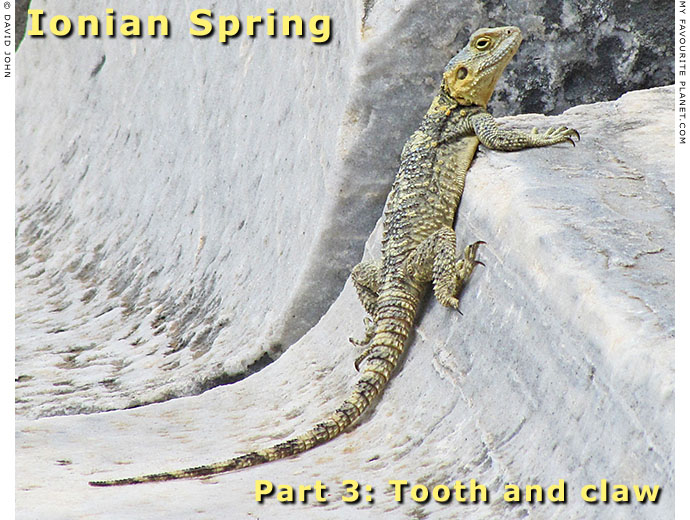
A starred agama lizard (Laudakia stellio) in the theatre of Miletus, Turkey.
Ionian Spring
Part 3 - Tooth and claw
... beak and hoof, snout and wing, itch and scratch: Ionian animal life in western Turkey. |
| |
|
Miletus (Greek, Μίλητος, Miletos; Latin, Miletus) was one the oldest and most important cities of ancient Ionia. When its harbour silted up, as at Ephesus and Priene, the ancient Greeks and Romans abandoned the place and went off somewhere else to seek their fortunes.
Unbothered by humans for centuries, plants and animals reconquered the decaying cities. Most of the animals make themselves scarce during daylight hours to avoid being eaten by the others or trampled upon by tourists visiting the archaeological sites. The dedicated nature lover will discover many creatures in the fields and woods and lurking among the rocks and undergrowths of the Ionian countryside. On this page you can see a few we found without really trying.
The starred agama lizard has a reputation for being shy, but this one did not seem overly concerned about being stared at as he basked in the spring sunshine on the marble seating of Miletus' huge theatre; in fact, it was clearly observing me with what one could imagine to be curiosity. Agamas are also said to be able to change colour according to mood and environment, though not quite in the spectacular way chameleons can. This, then, is an agama in its theatrical costume.
See some more Ionian lizards below. |
|

You have an appointment, Mr Cat? |
|
| |
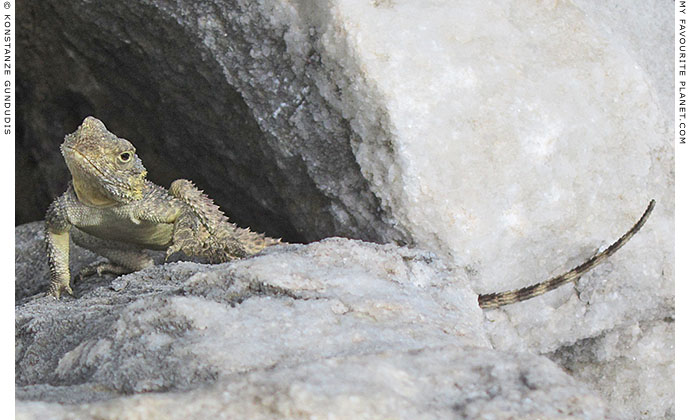
Another theatre-going starred agama in Miletus |
| |
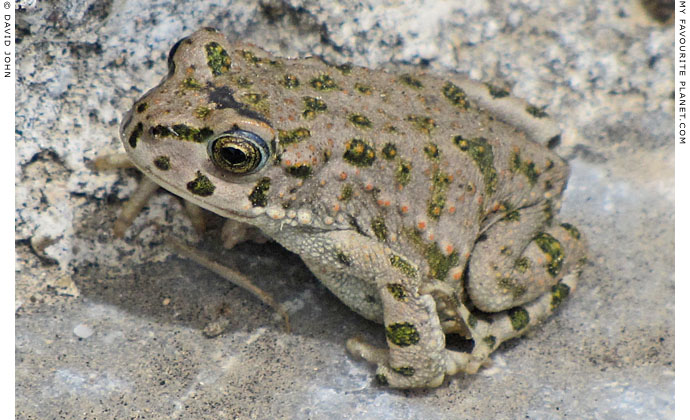
Mr Toad takes a breather
|
A row of tiny green toads (Bufo viridis) sat and hopped, sat and hopped along the diazoma, between the tiers of seating of the theatre of Miletus. They were only playing leapfrog, but didn't let me as close to them as the lizards.
They are only about 6 cm or less in length, and their camouflaged bodies and sudden quick movements make them really difficult to get in focus. Filmstars and other VIPs could do worse than to emulate the toads in order to evade the lenses of the paparazzi; the Bufo Look would cause quite a stir at next season's fashion shows as skinny models hop along the catwalks.
The toad above looks as though it is wearing make-up, with blue and gold touches around the eyes and the painstakingly applied scarlet dots along its warty side. Must take ages to get ready in the morning.
Apart from lizards, toads and frogs, I have often caught brief glimpses of snakes in Ionia, but they usually skidaddle as soon as they see me coming. A number of times I have seen a type of common large brown snake, harmless to humans (so I've been told), which hangs around in long grass. They literally leap as far as 2 metres to get out the way of humans. I am impressed each time I see this athletic feat, but a little disappointed by such a blatant act of aversion.
Read about the new Miletus Museum in Museum boom,
The Cheshire Cat Blog, July 2013. |
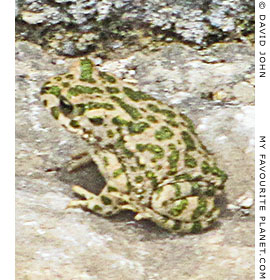
Ready... Steady... |
| |
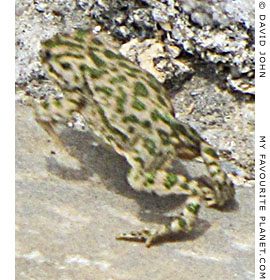
... Go!
Drat! Out of focus. Could we
run through that again, please?
Positions, everybody... |
| |
|
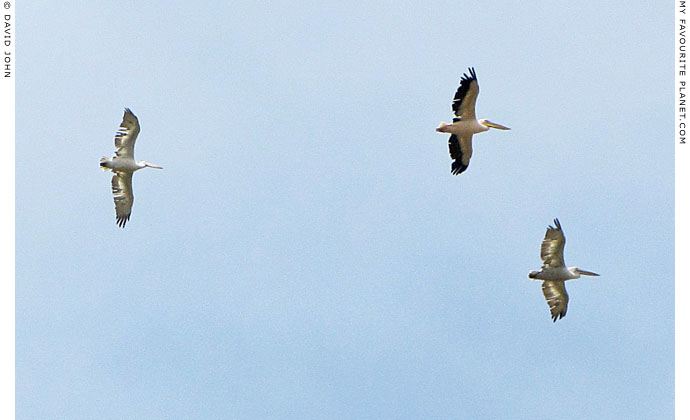
Pelicans flying high over Miletus
|
Turkey's Central Aegean coast is on the migration path of several bird species, including pelicans, storks, herons, cranes, falcons, geese, ducks and swallows, which in spring move en masse from winter quarters in Africa to their summer residences in western Asia and Europe.
Pelicans also frequently move around in groups to follow the fish. These are just three of a large group of pelicans flying over Miletus in May. No, I didn't count them, and have no idea where they were heading.
A wonderful bird is the pelican,
His bill will hold more than his belican,
He can take in his beak
Food enough for a week,
But I'm damned if I see how the helican.
Limerick by Dixon Lanier Merritt, 1910. |
|

A heron over Miletus |
|
|
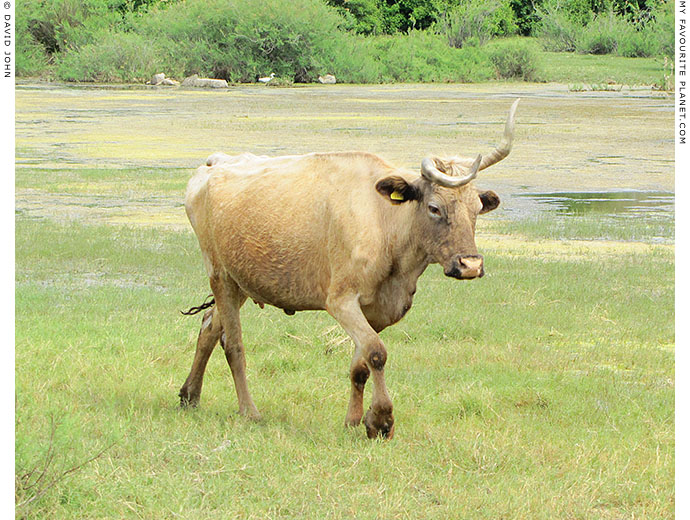
Nonchelant bovine
|
As mentioned in Ionian Spring part 2, the Maeander River silted up the once grand harbours and bays of ancient Miletus, turning the place into a marsh, waterlogged for much of the year.
Although you can get an overview of the city's remains from the Byzantine fort above the theatre, once you get down into the marshy land the lines of sight are blocked by hillocks and vegetation, and orientation along the paths between the various ruins can become confusing. The city's famous grid system of streets, designed by Hippodamos of Miletus, has disappeared, signposting is rudimentary and there is no yellow brick road.
Cattle are grazed here to keep the archaeological site from becoming totally overgrown. But its no easy life for the animals since it is soggy underfoot, there are so many sharp, spiny plants such as giant thistles (see part 2), and they are plagued by millions of flies and other insects.
This cow was definitely the odd-one-out in the local bovine society. Apart from her crooked horn, she was the only light-coloured animal here; all the others were dark brown, short-horned cattle. Perhaps this is why she also seemed a bit of a loner, and wasn't munching with the rest of the herd. |
|
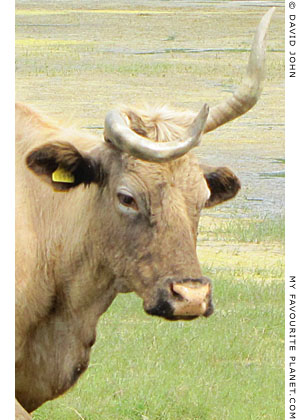
Old Crooked Horns |
|
| |
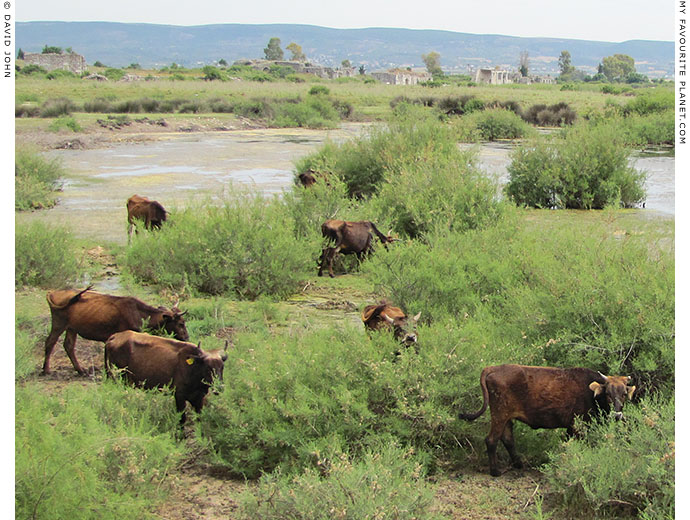
How now, brown cow? The rest of the herd in the harbour of ancient Miletus. |
| |

A cowboy and his pony in the former harbour of ancient Miletus
|
This lonesome cowboy, in charge of the cattle at Miletus, is quite a character in his quiet way. He has taken on the job of unofficial and unpaid tourist guide here. He happily shows visitors the way to the famous marble lions that lend their name to the "Lion Bay", which are under water and hidden among thick vegetation.
It is practically impossible to find the lions without the smiling cowhand's help. Trouble is, once you have walked along the dyke which keeps the water of the Maeander flood plain out of the site, and without which the place would be completely submerged, and scrambled through the bushes, the lions are a disappointment: all that remains of them are the bases and a little of their lower halves. Never mind, it's the thought that counts.
Like other farm workers in the region, he rides his typical chestnut pony without a saddle or stirrups; just a blanket or jacket thrown over the animal's back.
More Ionian cattle and another cowhand below. |
|
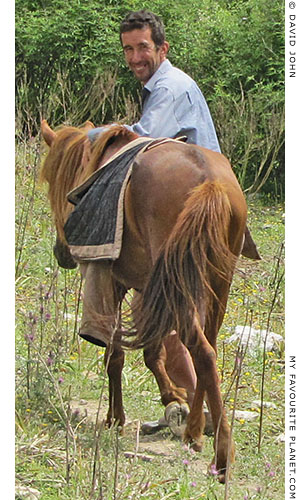
Across the Maeander Grande |
|
| |
| |
Priene |
 |
|

A trick of the tail
|
Topographically, Priene (Greek, Πριήνη; today near the village of Güllübahçe) was quite a different city to its southern neighbour Miletus. The grid of streets was laid out on the steep southeastern slope of Mount Mykale (Greek, Μυκάλη), today known as Samsun Daği. Much of this grid still exists, and this and the slope make it much easier to navigate around the melancholy ruins, though the gradient is steep.
A number of snake-eyed lizards (Ophisops elegans) skitter around the stones, eying up the tourists before disappearing into some impossibly narrow crevice. The sheen and patterns of their scales and their golden backs make them look as if they are made of metal, and the way their black eyes move up and down make it evident that they are inspecting you.
This lizard, in the Upper Gymnasium, had recently lost its tail. When threatened, many lizards present their tail to an enemy, and as the attacker grabs it the small reptile simply detaches itself from its rear appendage and escapes. Strange but true.
What kind of creature ended up with the tail between its teeth is anybody's guess. The lizards also fight among themselves: I was surprised by a pair of them in close combat leaping into the air above some tall grass. Real action heroes. Or was it a mating ritual?
Once again we see that curious insects get everywhere, exploring plants and other animals without fear or favour (see Ionian spring part 2). You can just about see the miniscule ant running around the lizard's scaly right foreleg. |
|
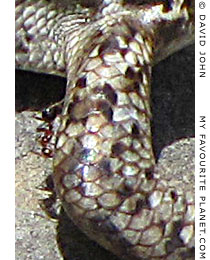
Hitchhiking ant |
|
| |
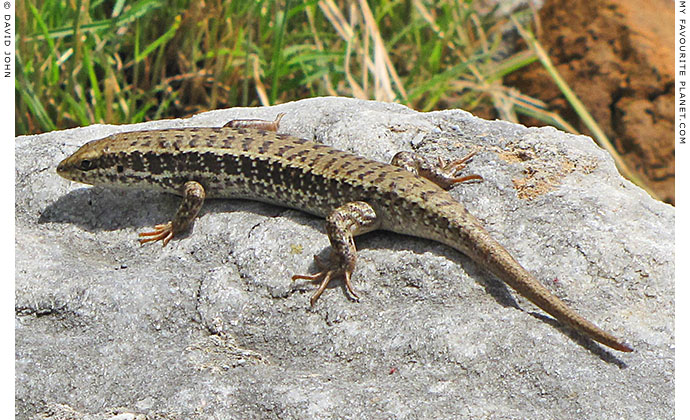
Snake eyes
|
Another Snake-eyed lizard at Priene's Upper Gymnasium. This one also appears to have dispensed with its tail at some point. Lost lizard tails grow back within about three months, but not to the great length or scaly beauty of the original: the replacement is much shorter, stiffer and rougher and supported by cartilage rather than more flexible vertebrae.
Their long, slender claws allow them to get an excellent grip, and stand or run around at speed, even on vertical stone surfaces. Zoom, there he goes. Gone. |
|
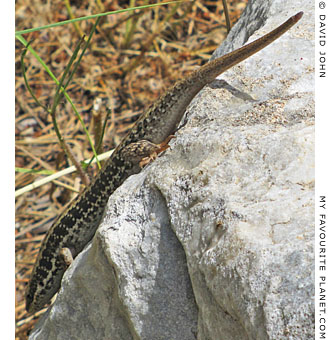
Downhill racer |
|
| |
| |
Didyma |
 |
|

The other side of the rainbow
|
Some 80 kilometres south of Kuşadası, the village of Didim, near the site of ancient Didyma, presents a different aspect of Turkish rural life. It is late Friday afternoon, the sun has come out, the tour buses have chugged off to take weary sightseers back to their cruise ships and hotels, and many of the villagers are at their prayers inside this mosque.
It is suddenly very quiet outside and the only sound is the screeching of swallows going about their spring business. The metal bars which support the arches of this former Greek Orthodox church provide a great perch for the avian migrants. They sit in rows chirping their swallow gibberish and watch the humans go by. Their banter sounds something between twittering and squabbling; let's call it squibbling.
When I came out of the mosque again, there was just one lone bird squibbbling to him/herself. They can't touch you for it, so I've been told. He/she seemed happy enough, and not at all bothered by a cat with a camera.
Tourists don't come to Didyma in the huge numbers which swamp Ephesus and Pergamon. Partly it's because of the distance from the main tourist zones, and partly because the sole attraction here is the enormous unfinished Hellenistic Temple of Apollo and its ancient oracle.
The oracle was a major tourist attraction in ancient times, and it is thought that it was a place of pilgrimage long before the Greeks settled around here at the beginning of the first millenium BC. A sacred road connected Didyma with the great Ionian city of Miletus, 20 km to the north. Today, a modern highway speeds tourists from Izmir airport to the busy beach resorts just south of here, such as Altinkum (Turkish for golden sand), beloved by Brits and fans of all-day English breakfasts. |
|
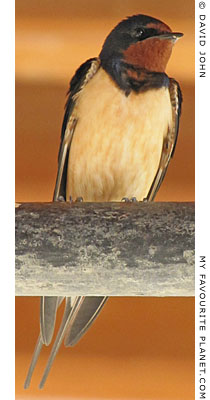
The great squibbler |
|
| |
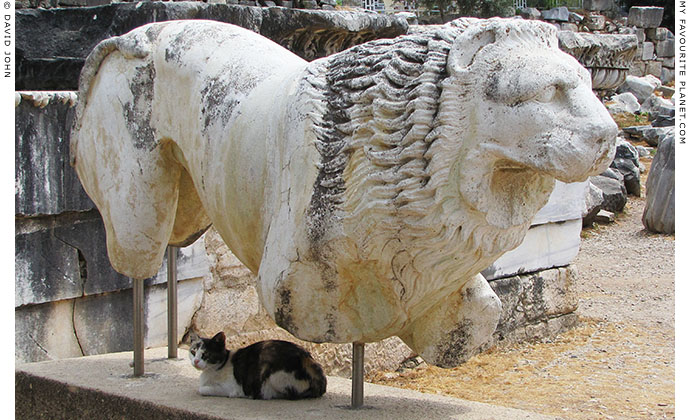
Made in the shade
|
A cat sits in the shade of an ancient marble lion in the Apollo Sanctuary of Didyma. Yes, you are quite right: a far too obvious juxtaposition. Nobody's forcing you to read this stuff, you know.
I have just seen another photo of this lion, taken over a year ago, with what looks like the very same cat sitting below it. Cats definitely have their favourite perches and haunts, and relish a good scrap to defend them. This one bares the scars to prove that it has survived several such territorial battles.
See a feline Mexican standoff in Ephesus below. |
|
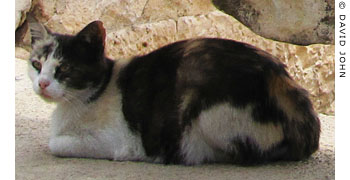
Didyma moggie |
|
| |
| |
Selçuk and Ephesus - storks |
 |
|
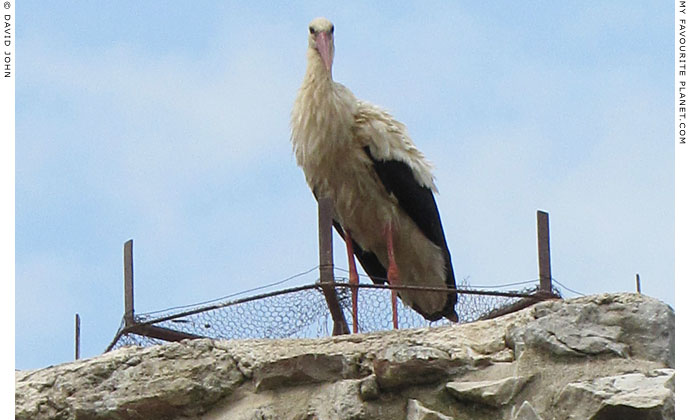
Waiting for the removals van |
| |
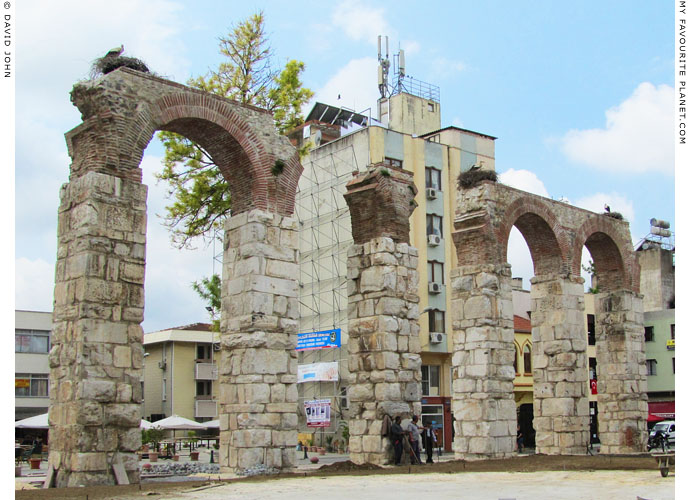
Storks nesting on part of the Byzantine aqueduct in Selçuk
|
White storks (Ciconia ciconia), like many other animal species, choose to live near humans. Perhaps, being creatures of habit, they just keep returning every spring to places they always did, before homo sapiens arrived; perhaps it's because people provide structures ideal for nest perches.
People generally not only tolerate storks but welcome them and even assist their nesting activities: the leggy birds do not compete with us for food and their diet includes rodents, snakes and other creatures we consider pests, making them unwitting allies of farmers. In recent times towns and villages have also realized that storks are great tourist attractions and help lend an open, hospitable, eco-friendly image to a place.
Until the 20th century the area around the abandoned ancient city of Ephesus had been sparsely populated for hundreds of years, and the Byzantine aqueduct running through Selçuk had long been derelict. As at other ruined cities, nature reclaimed the landscape. The fertile, marshy plain is an ideal hunting ground for storks which colonized it and built their nests atop the ruins.
Over the last three decades the human population of Selçuk has more than doubled to over 30,000. Space has become scarcer and the increase in human activity is a growing challenge to the natural environment. Still the storks return, and the people of the town have even constructed metal bases to support the often unstable nests (see photos above and below).
See also photos of storks in Selçuk taken in 2004 on Selçuk gallery 1, pages 21 - 28. |
|
|
| |
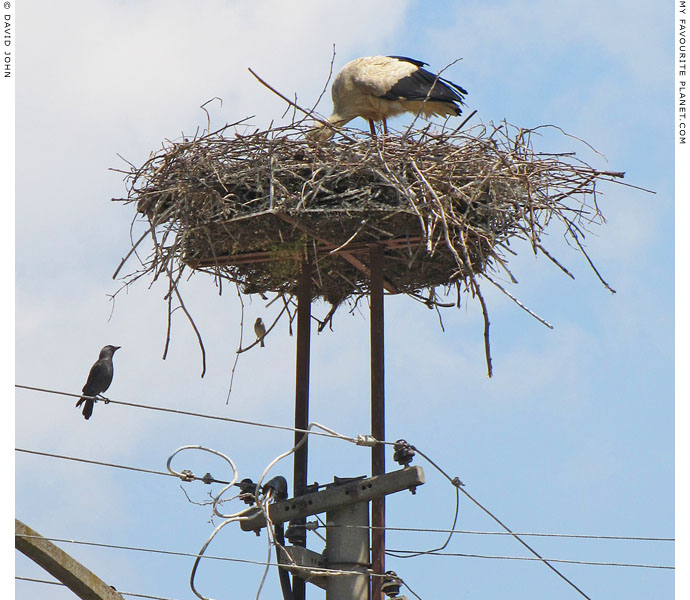
Spring cleaning
|
| Storks' nests always look as though they have just been thrown together with twigs, bits and pieces, but they take great care of them and are very houseproud. Often smaller birds build their nests beneath those of storks and others hang out nearby, for protection and in the hope of edible leftovers. |
|

Could I see the menu? |
|
| |
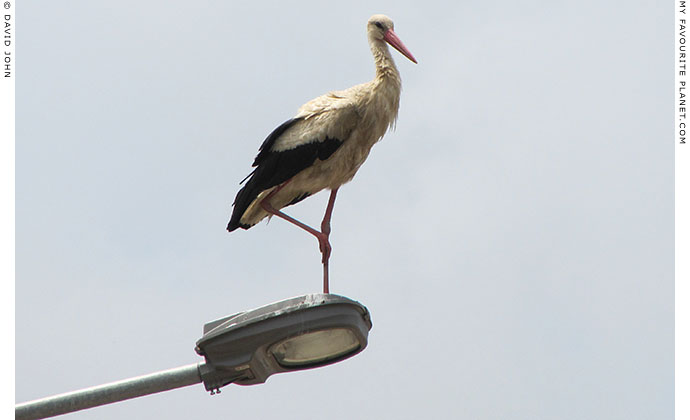
Stork scratch drama in Selçuk
|
| Suffering a terrible itch, this young stork made an emergency landing on a tall streetlamp near the Ephesus Museum in Selçuk for an urgent scratch. Balancing on the lamp's pole with one leg while trying to scratch with the other proved too much of a challenge, so it hopped onto the flatter surface of the lantern where it was more successful. What a relief! |
|
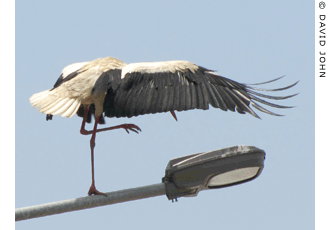
The itchy-and-scratchy dance |
|
| |
| |
Temple of Artemis, Ephesus |
 |
|
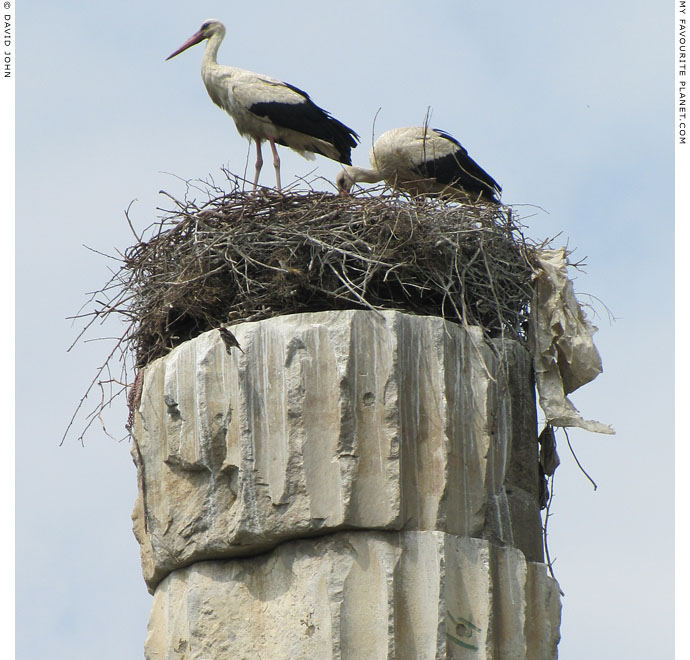
White storks nesting on top of a column of the Artemision in Ephesus
|
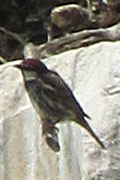
small fry |
|
The Temple of Artemis, or Artemision (Greek, Ἀρτεμίσιον), of Ephesus was the largest temple in the ancient Graeco-Roman world and one of its famous Seven Wonders, the list of man-made marvels compiled by Antipater of Sidon in the 2nd century AD (see Selçuk gallery 1, pages 3-4).
All that remains of the enormous edifice today is this reconstructed column and a few blocks of stone rising above the submerged foundations on the side of the road between Selçuk and Ephesus. John Turtle Wood, the British archaeologist who excavated the temple 1869, had to dig out over 6 metres of silt to uncover the ruins, leaving the deep depression known locally as "the English hole", which is waterlogged for much of the year.
The place may be a soggy disappointment for history lovers, but it is an oasis for plants and animals. Literally crowning the lone column, the stork's nest provides a poignant comment on human endeavours.
See more about storks and their nests at
Desperately seeking summer part 1. |
|
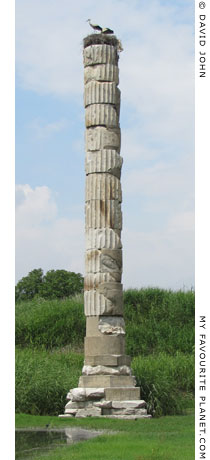
The only standing column
reconstructed at the
Temple of Artemis, Ephesus |
|
| |
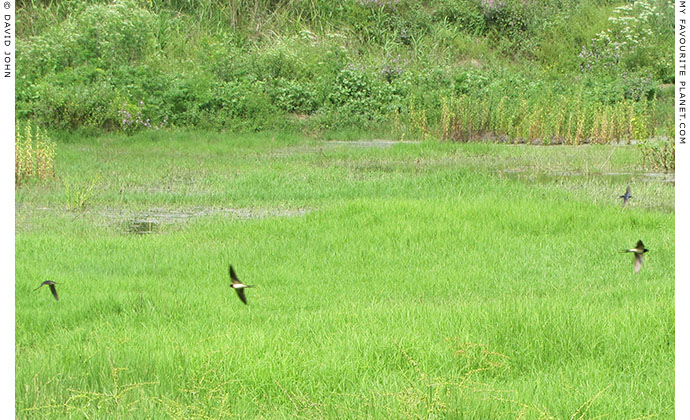
Swallows hunting insects above the submerged ruins of The Temple of Artemis. |
| |
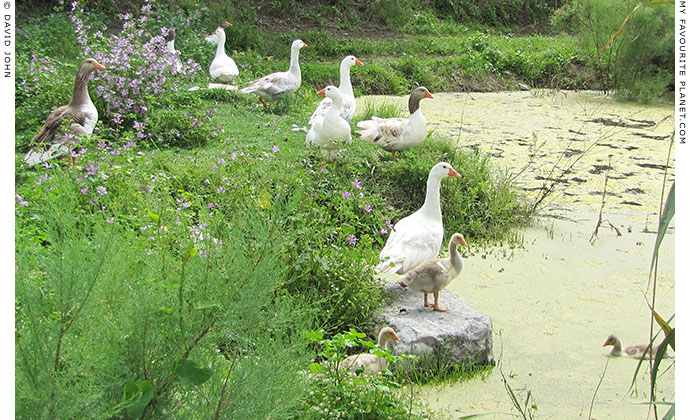
Geese look on and wonder at the amount of energy the swallows expend to catch their meagre lunch. |
| |
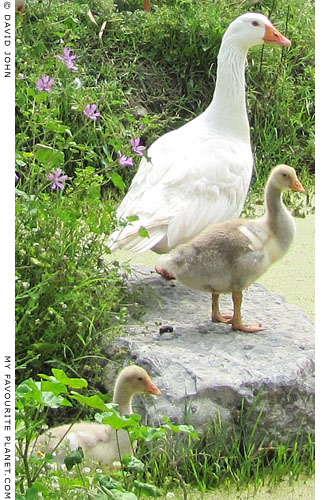
Adult goose and juvenile goslings |
|
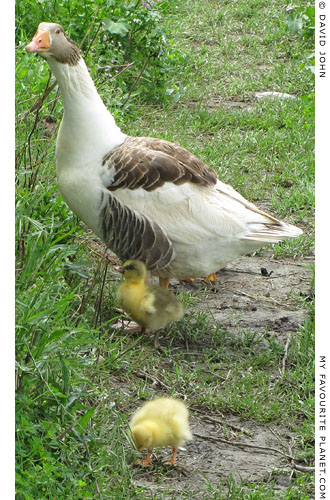
Mother goose and fluffy goslings |
|
| |
| |
Ephesus |
 |
|
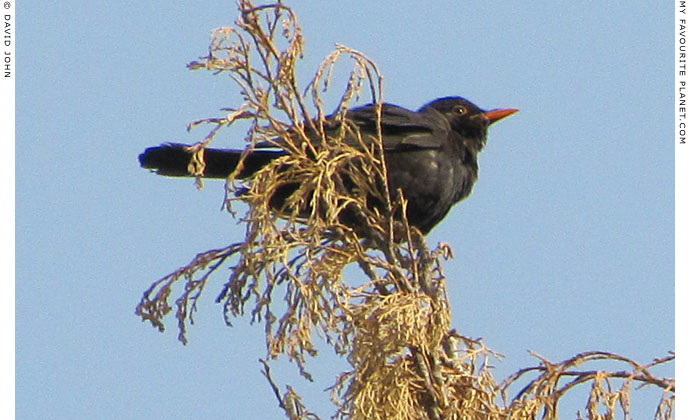
A blackbird in a tree in Ephesus |
| |
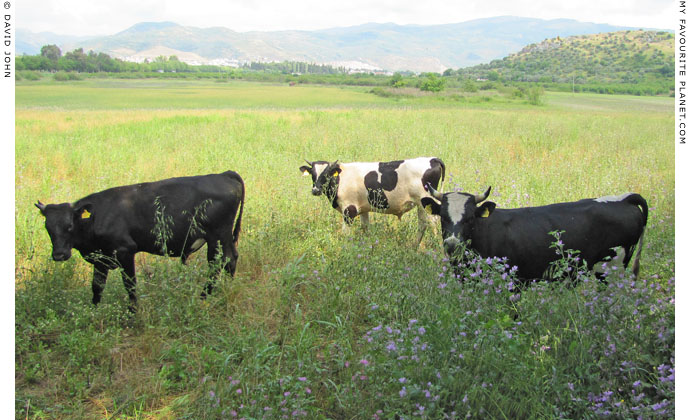
In clover: Ephesus cattle
|
| The cattle around Ephesus look a lot happier and healthier than the fly-plagued soggy-bottom bovines in Miletus (see above). And just look at expanse of lush, luscious pasture. Tuck in, lads and lasses. |
|

cow juice |
|
| |

A Turkish cowherd in Ephesus
|
| This cowboy didn't seem to have a pony, but maybe his steed was grazing nearby. He certainly travels light. |
|
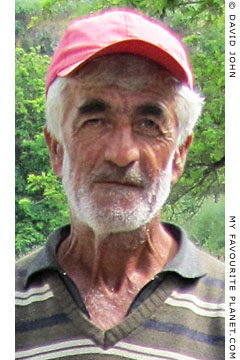
The face of experience |
|
| |
| |
Ephesus horses |
 |
|
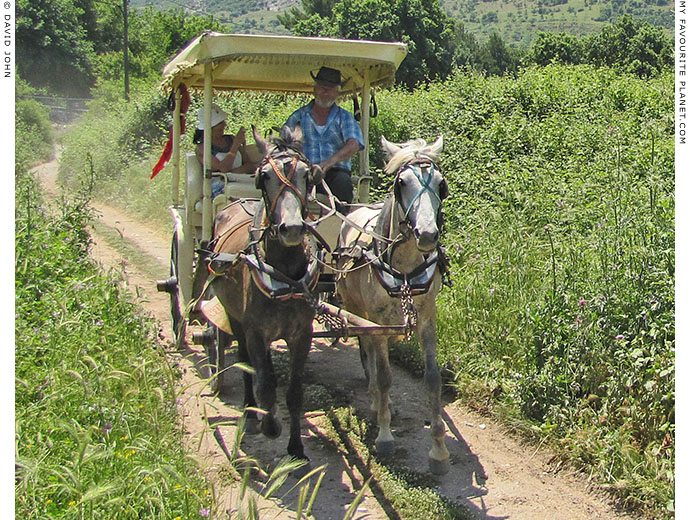
Ride like a god in Ephesus
|
The open horse-drawn carriages which whisk tourists around Ephesus are known here as faytons, after Phaeton (or Phaethon, Φαέθων, the Shining One), son of the sun god Helios (or son of Apollo), who nearly set the world in flames when he lost control of his father's chariot of the sun. Zeus prevented the disaster by stopping the chariot with one of his thunderbolts which also killed Phaeton. The moral of the story: never borrow your dad's chariot.
The name phaeton was given to sporty horse-drawn carriages in the early 19th century. |
|
|
| |
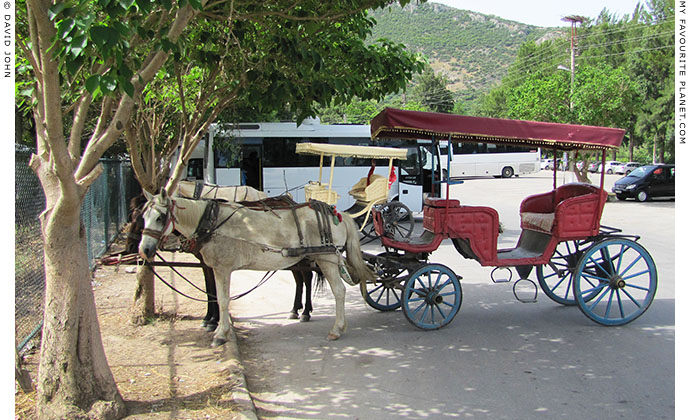
A fayton with a fringe on top
|
Two faytons in the bus and car park immediately in front of the lower entrance to the Ephesus archaeological site. They can also be found at the upper entrance and in the nearby town of Selçuk.
Fayton drivers tout for business at several key places around Selçuk and Ephesus, and will offer visitors a tour around the Ephesus countryside, including a visit to the nearby Cave of the Seven Sleepers, located along a small farm road between the two entrances. Tour options also include the Meryemana (House of the Virgin Mary, entrance 15 Turkish Lira, around 7 Euros), on a wooded hill 5 km south of Ephesus (see Ionian spring part 1).
At time of writing, a ride between the upper and lower entrances costs 40 Turkish Lira, and between Ephesus and Selçuk 30 Turkish Lira. The faytons seat four passengers. |
|
|
| |
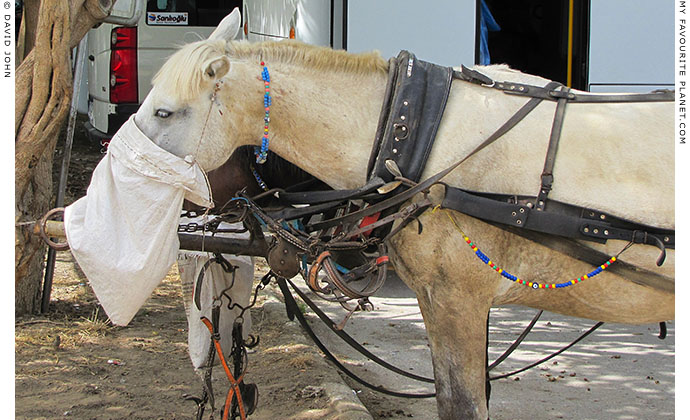
Lunch break for the sun god's steeds |
| |
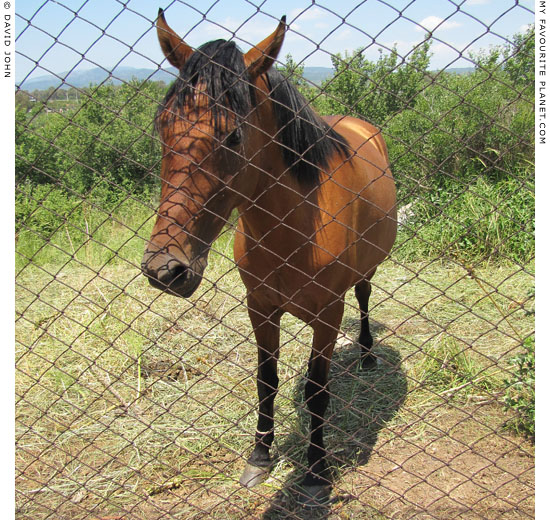
Give me land, lots of land under starry skies above, don't fence me in |
| |
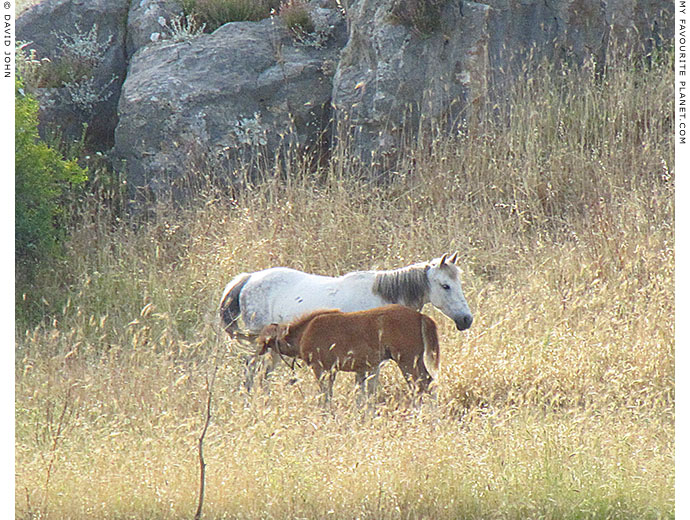
A mare and foal in a field near the Cave of the Seven Sleepers, Ephesus, Turkey. |
| |
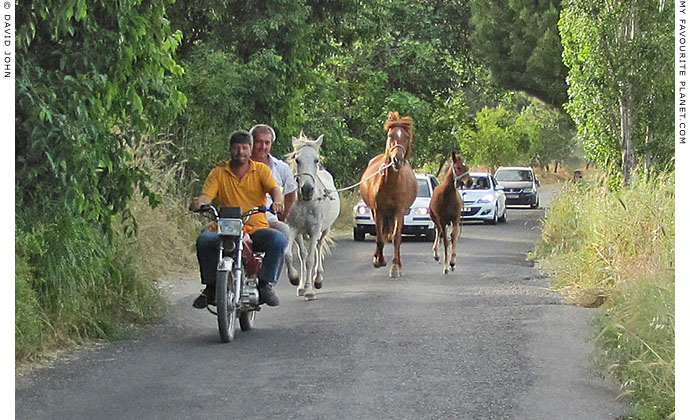
On the trot: horses being taken home at the end of the day's work. |
|
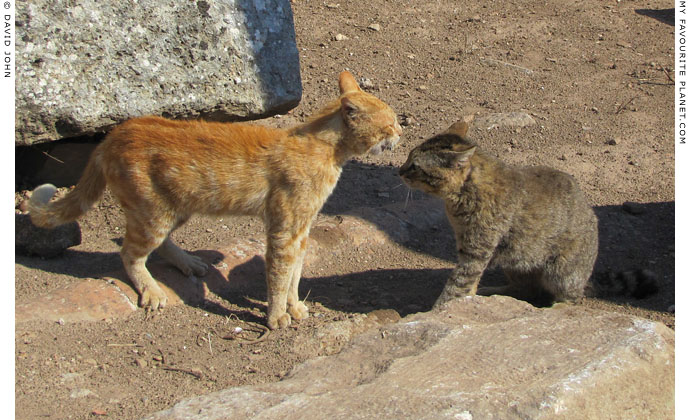
Katzenjammer in Ephesus
|
Two cats were engaged in a mysterious feline status interaction on a high embankment along the "Marble Street", next to the Great Theatre of Ephesus. Their caterwaul attracted the attention of passing tourists. A young Turkish man thought it would be fun to throw a large chunk of ancient marble at them; it hit the tabby in the ribs with a sickening thud. The man laughed at his lucky strike and looked around him for approval, but the other people, including his wife and children, were definitely not amused, though nobody raised a murmur of protest agianst the callous act.
The tabby, for its part, seemed too hypnotized by the confrontation it was engaged in to react. No doubt it felt the pain later, and perhaps the injury affected its combat readiness.
Suddenly the two cats sprang at each other and fell as one from the 3 metre high embankment down to street level. There followed a long head-to-head stand-off with Chinese catsong and the occasional burst of wrestling. Ginger definitely seemed to be gaining the upper paw and Tabby began to cower in submission...
... And then I had to go, and never found out what happened next. Perhaps I'll come across the video on YouTube one day. |
|
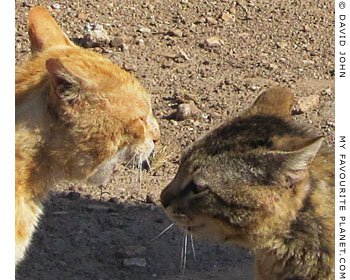
Feline fracas |
|
| |
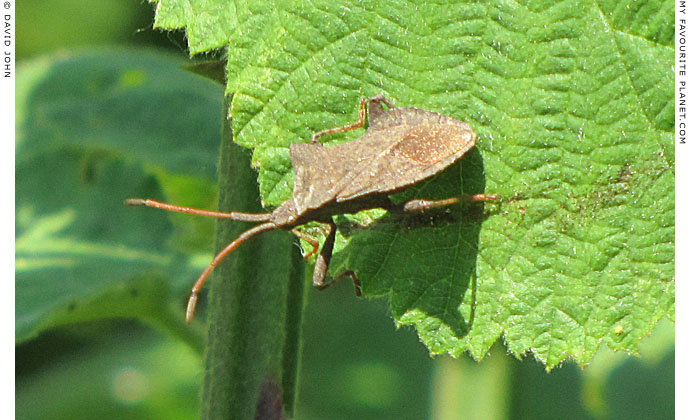
Sunbathing bug, Ephesus, Turkey
See more bugs on plants in Ionian spring part 2. |
| |
| |
Güzelçamlı |
 |
|
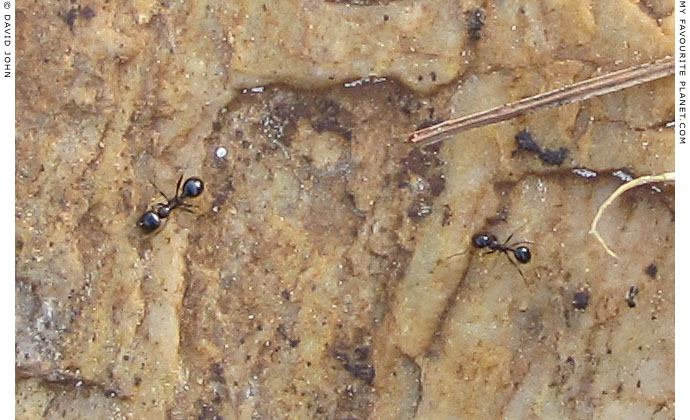
Ants exploring an ancient slab of marble in Güzelçamlı
See more about Güzelçamlı in Ionian spring part 1. |
| |
| |
Akköy |
 |
|

Considering leaving home?
|
The sleepy village of Akköy, 5 km south of Miletus, is where passengers change buses for the local villages, archaeological sites and beach resorts.
On a slow spring afternoon the place seemed to be inhabited solely by dogs who moved around in a dozy dream. The white dog walked up the main street to the junction with the Didyma to Priene road and then stopped, as if it couldn't remember why it had come there. After a while looking around for guidance or some sort of sign, it gave up and plodded back down the street whence it came.
The rest of my sojourn in Akköy was not quite as exciting as this. |
|

Can I borrow your navi? |
|
| |
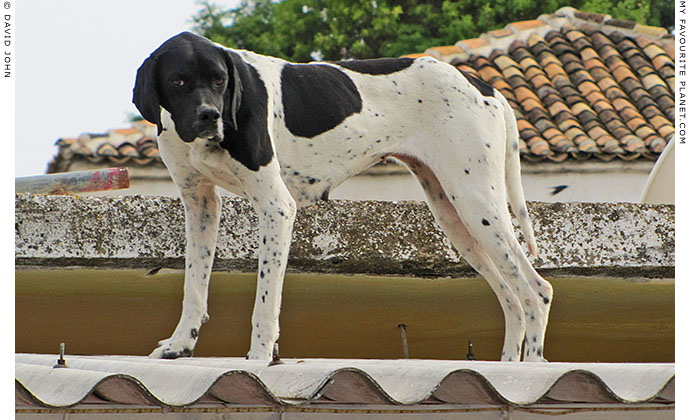
Dog on a hot tin roof
|
| When a small lizard eyes you up it's amusing; when a large guard dog gives you the once-over it can be unnerving. Good job this one is on the roof of the village grocery shop and not on the street. After checking me out it quickly got bored, sat down and studiously ignored me. |
|
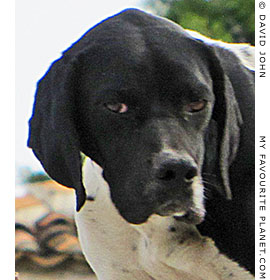
Looking for something, Mr Cat? |
|
| |
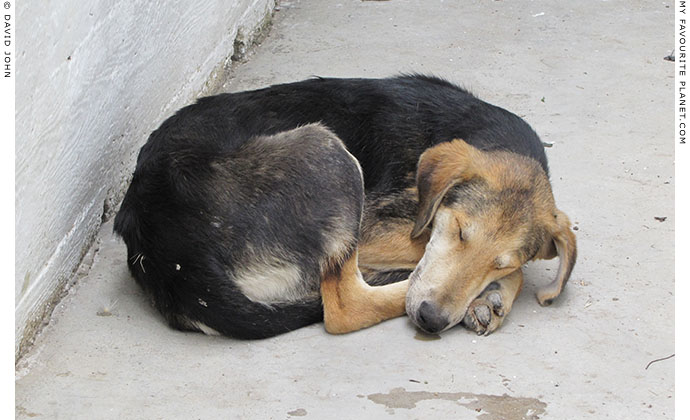
Let him lie. Sleeping dog in Akköy village, near Miletus. |
| |
| |
So long, Ionia |
 |
|

It's time to climb aboard the sun god's chariot and head off elswehere.
I always find it hard to leave this part of the world, its friendly people, pleasant climate,
fascinating landscapes and wildlife and intriguing signs of cultures ancient and modern.
Much of the information gathered on this trip will be appearing on My Favourite Planet in the
near future, as updates to existing travel guides, as well as new guides to places in Ionia. |
|
Articles and photos copyright © David John 2013
Additional photos © Konstanze Gundudis 2013
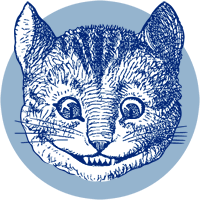
The Cheshire Cat Blog at My Favourite Planet Blogs
We welcome considerate responses to these articles
and all other content on My Favourite Planet.
Please get in contact.
The photos on this page are copyright protected.
Please do not use them without permission.
If you wish to use any of the photos for your website,
blog, project or publication, please get in contact.
Higher resolution versions are available on request. |
 |
Visit the My Favourite Planet Group on Facebook.
Join the group, write a message or comment,
post photos and videos, start a discussion... |
|
Views of blog authors do not necessarily reflect those of the publishers
or anyone else at, on or in the vicinity of My Favourite Planet. |
 |
| |
|
|
| |
| |
 |
| |
 |
| |
 |
| |
 |
| |
 |
| |
 |
| |
George Alvanos
rooms
in Kavala's historic Panagia District
Anthemiou 35,
Kavala, Greece
kavalarooms.gr |
| |
| |
Olive Garden Restaurant
Kastellorizo,
Greece +30 22460 49 109
kastellorizo.de |
| |
| |
Papoutsis
Travel Agency
Kastellorizo,
Greece +30 22460 49 286
greeklodgings.gr |
| |
| |
|